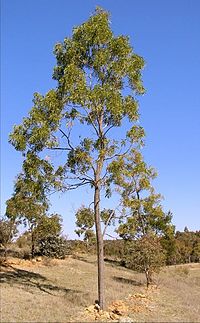Difference between revisions of "Acacia implexa"
| Line 2: | Line 2: | ||
|familia=Fabaceae | |familia=Fabaceae | ||
|genus=Acacia | |genus=Acacia | ||
| − | |species=implexa | + | |species=implexa |
| − | |common_name=Hickory, | + | |common_name=Lightwood, Hickory Wattle, Screw-pod Wattle, Bastard Myall, Fish Wattle, Broad-leaf Wattle |
|name_ref=Flora - A Gardener's Encyclopedia | |name_ref=Flora - A Gardener's Encyclopedia | ||
|habit=tree | |habit=tree | ||
| Line 27: | Line 27: | ||
|usda_ref=Flora - A Gardener's Encyclopedia | |usda_ref=Flora - A Gardener's Encyclopedia | ||
|max_zone=11 | |max_zone=11 | ||
| − | |image= | + | |image=A.Implexa.jpg |
| − | + | |image_width=200 | |
| − | |||
| − | |||
| − | |||
| − | |||
| − | |||
| − | |||
| − | |||
| − | |||
| − | |||
| − | |||
| − | |||
| − | |||
| − | |||
| − | |||
| − | |||
| − | |||
| − | |||
| − | |||
| − | |||
| − | | image_width = | ||
| − | |||
| − | |||
| − | |||
| − | |||
| − | |||
| − | |||
| − | |||
| − | |||
| − | |||
| − | |||
}} | }} | ||
| + | '''Acacia implexa''' is an [[Australian]] [[Acacia]], used for furniture making. Its common name is Lightwood. | ||
| + | |||
{{Inc| | {{Inc| | ||
| − | + | Acacia implexa, Benth. A tall tree, 50 ft. high, with light green foliage and rough bark: phyll. falcate- lanceolate, acuminate, with a more or less hooked point, 4-7 in. long, 3/8-3/4in. wide, veins 3-5, with finer parallel veins between; no gland: fls. cream-yellow, in racemes much shorter than phyll., 40-50 in a head; peduncles 3/8in. long: pod curved, often like an interrogation point, light brown with nerve-like margin, more or less constricted and contracted between the seeds, 4-6 in. long, 1/4in. wide; seeds longitudinal; funicle club-shaped, folded once or twice at end of seed—Distinguished from A. melanoxylon by the more pointed and hooked phyll., while the funicle is cream-colored and folded at the end of the seed instead of being scarlet and twice encircling it as in A. melanoxylon. | |
| − | Acacia implexa, Benth | ||
{{SCH}} | {{SCH}} | ||
}} | }} | ||
| Line 97: | Line 68: | ||
{{stub}} | {{stub}} | ||
| − | + | __NOTOC__ | |
| − | |||
| − | |||
Latest revision as of 00:57, 21 July 2010
| Habit | tree
| |
|---|---|---|
| Height: | ⇕ | 15 ft"ft" can not be assigned to a declared number type with value 15. to 50 ft"ft" can not be assigned to a declared number type with value 50. |
| Width: | ⇔ | 12 ft"ft" can not be assigned to a declared number type with value 12. |
| Lifespan: | ⌛ | perennial |
| Bloom: | ❀ | early summer, mid summer, late summer, early fall, mid fall, late fall |
| Exposure: | ☼ | sun |
|---|---|---|
| Features: | ✓ | flowers |
| USDA Zones: | 8 to 11 | |
| Flower features: | ❀ | orange, yellow |
|
Fabaceae > |
Acacia > |
implexa > |
Acacia implexa is an Australian Acacia, used for furniture making. Its common name is Lightwood.
Read about Acacia implexa in the Standard Cyclopedia of Horticulture
|
|---|
|
Acacia implexa, Benth. A tall tree, 50 ft. high, with light green foliage and rough bark: phyll. falcate- lanceolate, acuminate, with a more or less hooked point, 4-7 in. long, 3/8-3/4in. wide, veins 3-5, with finer parallel veins between; no gland: fls. cream-yellow, in racemes much shorter than phyll., 40-50 in a head; peduncles 3/8in. long: pod curved, often like an interrogation point, light brown with nerve-like margin, more or less constricted and contracted between the seeds, 4-6 in. long, 1/4in. wide; seeds longitudinal; funicle club-shaped, folded once or twice at end of seed—Distinguished from A. melanoxylon by the more pointed and hooked phyll., while the funicle is cream-colored and folded at the end of the seed instead of being scarlet and twice encircling it as in A. melanoxylon. CH
|
Cultivation
- Do you have cultivation info on this plant? Edit this section!
Propagation
- Do you have propagation info on this plant? Edit this section!
Pests and diseases
- Do you have pest and disease info on this plant? Edit this section!
Species
Gallery
If you have a photo of this plant, please upload it! Plus, there may be other photos available for you to add.
References
- Standard Cyclopedia of Horticulture, by L. H. Bailey, MacMillan Co., 1963
External links
- w:Acacia implexa. Some of the material on this page may be from Wikipedia, under the Creative Commons license.
- Acacia implexa QR Code (Size 50, 100, 200, 500)

